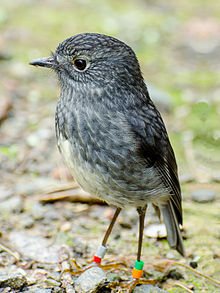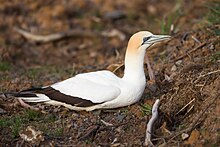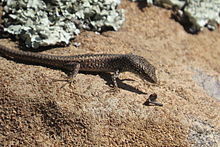
Seabirds are birds that are adapted to life within the marine environment. While seabirds vary greatly in lifestyle, behaviour and physiology, they often exhibit striking convergent evolution, as the same environmental problems and feeding niches have resulted in similar adaptations. The first seabirds evolved in the Cretaceous period, while modern seabird families emerged in the Paleogene.

The family Procellariidae is a group of seabirds that comprises the fulmarine petrels, the gadfly petrels, the diving petrels, the prions, and the shearwaters. This family is part of the bird order Procellariiformes, which also includes the albatrosses and the storm petrels.
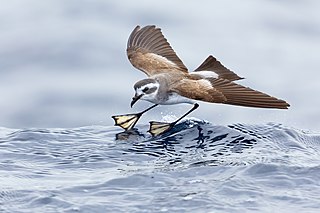
The white-faced storm petrel, also known as white-faced petrel or frigate petrel is a small seabird of the austral storm petrel family Oceanitidae. It is the only member of the monotypic genus Pelagodroma. It is widely distributed across the northern and southern hemisphere, especially around the coastal and open ocean waters of southern Australia, New Zealand, Tristan da Cunha, Cabo Verde, the Canary islands and the Selvagens islands.
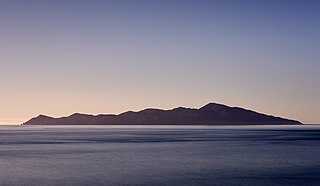
Kapiti Island, sometimes written as Kāpiti Island, is an island nature reserve located 5.6 km (3 mi) off the west coast of the lower North Island of New Zealand and within the Kāpiti Coast District. Parts of the island were previously farmed, but it is now a predator-free sanctuary for endemic birds, including many endangered birds. The island is 10 km (6.2 mi) long, running southwest/northeast, and roughly 2 km (1.2 mi) wide, being more or less rectangular in shape, and has an area of 19.65 km2 (7.59 sq mi).

The magenta petrel, or Chatham Island tāiko, is a small seabird in the gadfly petrel genus, Pterodroma. Found exclusively on Chatham Island, New Zealand, it is one of the rarest birds in the world, believed to be extinct for over 100 years before its rediscovery in the 1970s.

The Australasian gannet, also known as the Australian gannet or tākapu, is a large seabird of the booby and gannet family, Sulidae. Adults are mostly white, with black flight feathers at the wingtips and lining the trailing edge of the wing. The central tail feathers are also black. The head is tinged buff-yellow, with a pearly grey bill edged in dark grey or black, and blue-rimmed eyes. Young birds have mottled plumage in their first year, dark above and light below. The head is an intermediate mottled grey, with a dark bill. The birds gradually acquire more white in subsequent seasons until they reach maturity after five years.

The Chatham albatross, also known as the Chatham mollymawk or Chatham Island mollymawk, is a medium-sized black-and-white albatross which breeds only on The Pyramid, a large rock stack in the Chatham Islands, New Zealand (Aotearoa). It is sometimes treated as a subspecies of the shy albatross Thalassarche cauta. It is the smallest of the shy albatross group.

Mana Island is the smaller of two islands that lie off the southwest coast of the North Island of New Zealand. The name of the Island is an abbreviation of the Maori name Te Mana o Kupe, which means "The Mana of Kupe".

The Westland petrel(Procellaria westlandica),, also known as the Westland black petrel, is a moderately large seabird in the petrel family Procellariidae, that is endemic to New Zealand. Described by Robert Falla in 1946, it is a stocky bird weighing approximately 1,100 grams (39 oz), and is one of the largest of the burrowing petrels. It is a dark blackish-brown colour with black legs and feet. It has a pale yellow bill with a dark tip.
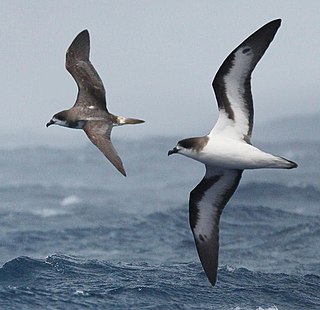
The Bermuda petrel is a gadfly petrel. Commonly known in Bermuda as the cahow, a name derived from its eerie cries, this nocturnal ground-nesting seabird is the national bird of Bermuda, pictured on Bermudian currency. Bermuda petrels are the second rarest seabird on the planet. They have medium-sized bodies and long wings, a greyish-black crown and collar, dark grey upper-wings and tail, white upper-tail coverts and white under-wings edged with black, and the underparts are completely white.
Saint Helena, Ascension Island and Tristan da Cunha, as well the other uninhabited islands nearby, are a haven for wildlife in the middle of the Atlantic Ocean. The islands are or were home to much endemic flora and fauna, especially invertebrates, and many endemic fish species are found in the reef ecosystems off the islands. The islands have been identified by BirdLife International as Important Bird Areas for both their endemic landbirds and breeding seabirds.
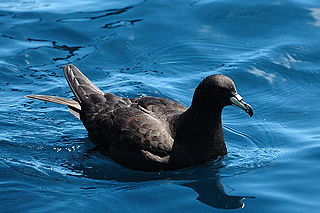
The black petrel, also called Parkinson's petrel, is a medium-sized, black-plumaged petrel, the smallest of the Procellaria. The species is an endemic breeder of New Zealand, breeding only on Great Barrier Island and Little Barrier Island, off the North Island. At sea it disperses as far as Australia and Ecuador.

Gould's petrel is a species of seabird in the family Procellariidae. The common name commemorates the English ornithologist and bird artist John Gould (1804–1881).
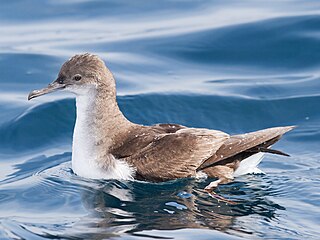
The fluttering shearwater is a species of seabird in the family Procellariidae. It is endemic to New Zealand and migrates to Australia and the Solomon Islands. Its natural habitats are open seas and rocky shores. It has been known as Forster's shearwater in the past.
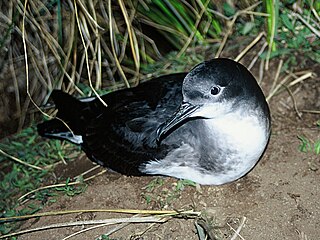
Hutton's shearwater is a medium-sized ocean-going seabird in the family Procellariidae. Its range is Australian and New Zealand waters, but it breeds only in mainland New Zealand. Its conservation status is Endangered, because there are just two remaining breeding colonies, located in the Seaward Kaikōura Range. Six other shearwater colonies have been wiped out by introduced pigs. Hutton's shearwater is the only seabird in the world that is known to breed in alpine areas. Conservation measures for the bird include community initiatives to rescue birds that crash-land at night on streets in Kaikōura, and the establishment of a protected area on the Kaikōura Peninsula including a predator-proof fence, man-made burrows, and translocating fledglings from the remaining colonies.
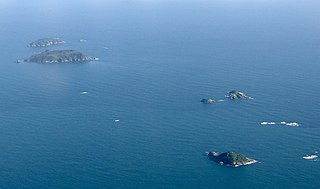
The Noises are a collection of islands lying northeast of Rakino Island in Auckland's Hauraki Gulf, off the coast of the North Island of New Zealand. The largest and most forested islands are Ōtata and Motuhoropapa; Orarapa and Maria/Ruapuke are also significant. After a rat eradication campaign in the 1960s, Maria was the first New Zealand island to become predator-free. The lack of invasive predators, intact native forest, and large numbers of breeding seabirds give the Noises significant conservation value. There has however been a marked decline in marine biodiversity surrounding the islands from over-fishing.

Motu Matakohe, also known as Matakohe or Limestone Island, is a 37 hectares island in the upper reaches of Whangārei Harbour, just off Onerahi, a seaside suburb of the city of Whangārei, Northland, New Zealand. Used for farming and industry for many years, the island is an example of ecological island restoration by a volunteer community group.

Seabirds include some of the most threatened taxa anywhere in the world. For example, of extant albatross species, 82% are listed as threatened, endangered, or critically endangered by the International Union for Conservation of Nature. The two leading threats to seabirds are accidental bycatch by commercial fishing operations and introduced mammals on their breeding islands. Mammals are typically brought to remote islands by humans either accidentally as stowaways on ships, or deliberately for hunting, ranching, or biological control of previously introduced species. Introduced mammals have a multitude of negative effects on seabirds including direct and indirect effects. Direct effects include predation and disruption of breeding activities, and indirect effects include habitat transformation due to overgrazing and major shifts in nutrient cycling due to a halting of nutrient subsidies from seabird excrement. There are other invasive species on islands that wreak havoc on native bird populations, but mammals are by far the most commonly introduced species to islands and the most detrimental to breeding seabirds. Despite efforts to remove introduced mammals from these remote islands, invasive mammals are still present on roughly 80% of islands worldwide.

Motuora is an 80 ha island nature reserve in the western Hauraki Gulf, on the north-eastern coast of New Zealand's North Island. It lies some 6.2 km (3.9 mi) south-west of Kawau Island, 5 km (3.1 mi) east of Mahurangi Heads and 35 kilometres (22 mi) north of the city of Auckland.
Nigel was an Australasian gannet who lived on Mana Island, off the coast of the city of Porirua in New Zealand. For most of his time there he was the only gannet on the island, and for this reason was nicknamed "no mates" Nigel and the "world's loneliest seabird". He arrived after conservationist efforts to re-establish a gannet colony on the island, which previously had a gannet colony. Part of the effort including building concrete statues of fake gannets. He chose one of them as a mate and made a nest for it. His death in 2018 received worldwide media attention.



